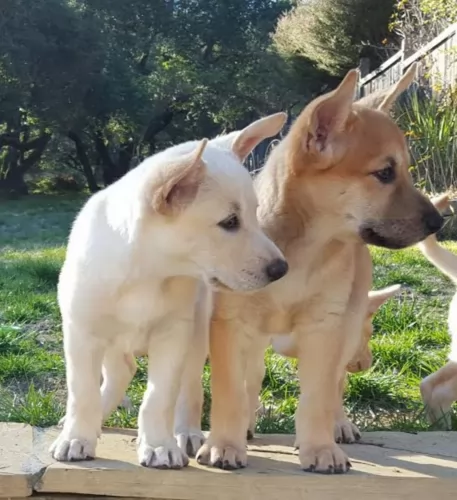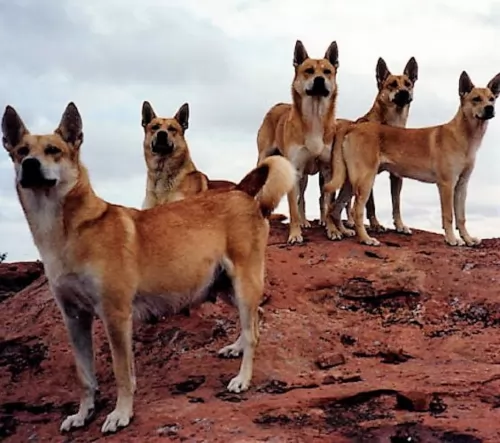 Petzlover
PetzloverCarolina Dog is originated from United States but Santal Hound is originated from India. Carolina Dog may grow 16 cm / 7 inches higher than Santal Hound. Carolina Dog may weigh 8 kg / 18 pounds more than Santal Hound. Both Carolina Dog and Santal Hound has almost same life span. Both Carolina Dog and Santal Hound has almost same litter size. Carolina Dog requires Moderate Maintenance. But Santal Hound requires Low Maintenance
 The Carolina dog comes from wild dogs that used to run with the Paleo-Indians of North America, and today they can still be found in their wild state near the Georgia-South Carolina border.
The Carolina dog comes from wild dogs that used to run with the Paleo-Indians of North America, and today they can still be found in their wild state near the Georgia-South Carolina border.
Many scientists believe that the dog was first domesticated from the wolf thousands and thousands of years ago. Today there aren’t many records on the Carolina Dog’s history and it isn’t sure how long they lived their feral lifestyle in the American South, but it seems as though it was for hundreds of years.
You could say that the modern history of the Carolina Dog started in the 1980s. Dr. Pam Brisbin found a puppy at a dump site which looked like the Australian Dingo. Dr Brisbin and other scientists concluded that the Carolina Dog was a remnant of primitive dogs. Since those times the Carolina Dog has adapted well to being a domesticated pet.
The Santal Hound has always been used for hunting and these Indian pariah dogs haven’t changed much over the years.
It is a small red Indian indigenous dog. It is named after the Santal tribe who used the dog for hunting. They sometimes refer to the dog as Seuta and Kukur.
When you do research on the Santal Hound, you will mostly find it among indigenous peoples. It isn’t only found in India but in Africa, being found among the different nomadic hunting tribes in East Africa.
 The Carolina dog is part of the Sighthounds Group and looks a bit like a Dingo, German Shepherd and Wolf mix. He has fairly long, pointed erect ears, a sharp wolf-like snout and a long tail that curves when raised.
The Carolina dog is part of the Sighthounds Group and looks a bit like a Dingo, German Shepherd and Wolf mix. He has fairly long, pointed erect ears, a sharp wolf-like snout and a long tail that curves when raised.
The Carolina dog has been re-discovered however and when trained and socialized, they make splendid pets. It’s a medium sized dog standing at 45–61cm and weighing from 15–20kg. He is slender, muscular and athletic with a coat that is short and fairly smooth. Colors for the Carolina dog vary and he can be fawn colored, a gingerish color, black and tan and can have some white areas on the paws, chest, muzzle and tail.
The Carolina Dog has been a wild dog, belonging to a pack and while he isn’t aggressive, he is nervous and aloof around strangers. Good training and socialization provides him with the skills to get along well with his human family as well as with children and other pets in the home.
Because this dog has always been wild, they tend to maintain some of their wild, independent nature and they can be difficult to train and it requires firmness and patience with him, but he is an intelligent breed.
The Santal is considered a small to medium sized dog standing at between 40 and 45cm in height and weighing between 9 and 12 kilograms.
It is also slightly built with fine bones. The coat of the dog is reddish brown or yellow-brown, the eyes are almond shaped and brown and the muzzle is pointed. The ears of the dog are erect and point forward. The tail of this dog is usually curled over the dog’s back. The dog doesn’t really bark as such but howls instead. It has small paws and walks with a high-stepping style like a prancing horse.
These dogs are calm, independent, loving and loyal and also affectionate with their human family. He is cool with strangers.
They are alert, intelligent dogs and you certainly won’t have any trouble teaching him a few simple commands. He cleans himself like a cat. He seems to understand what you say as he always cocks his head to one side when you talk to him. He is a playful dog and will love to be involved with games with the children.
He can also get on well with other dogs in the family. He is capable of adapting to life in the city or the countryside just so long as his exercise needs are met.
 The Carolina Dog is a medium-sized dog which has managed to survive well in the wild environment. It is this life in the wilds which has made the dog to be shy and aloof around strangers.
The Carolina Dog is a medium-sized dog which has managed to survive well in the wild environment. It is this life in the wilds which has made the dog to be shy and aloof around strangers.
They are skilled and intelligent and when domesticated they make extraordinary pets even though he isn’t an overly affectionate dog. It is why he requires early socialization so that he doesn’t grow up shunning humans.
With training however, the Carolina Dog becomes a well-adjusted, loving and social member of the family.
The Santal dog is an unusual dog with some unique characteristics. He hasn’t got any particularly exceptional characteristics either, but he promises to make you a good pet.
He is capable of providing you with lots of love, and on top of that he is a low maintenance dog too.
When you bring him into your home, you’re going to get yourself a loyal, loving pet and companion.
 The Carolina Dog is a fairly healthy breed. You won’t have to be rushing off to the vet often with him if you look after him well in terms of a good diet, a food amount of exercise and plenty of love and attention. In fact breeders of the Carolina Dog have noted that they haven’t seen any cases of genetically inheritable diseases with this robust dog.
The Carolina Dog is a fairly healthy breed. You won’t have to be rushing off to the vet often with him if you look after him well in terms of a good diet, a food amount of exercise and plenty of love and attention. In fact breeders of the Carolina Dog have noted that they haven’t seen any cases of genetically inheritable diseases with this robust dog.
However with all dogs, no matter how healthy they are, there can be problems. Problems common to domestic dogs can include skeletal and visual problems. Many dog owners have their pets tested to identify some of the potential health defects that some dogs are prone to. This can include hip dysplasia, cataracts, cancer and PRA or Progressive Retinal Atrophy.
Dogs stand a better chance of avoiding sickness if they are fed well and they get a fair amount of exercise. But our fur kids can get sick anytime really, and it pays to know about some of the dangerous diseases they can succumb to -
Your dog will have a fever, he will be lethargic and have diarrhea with vomiting. It is a contagious virus affecting dogs that come into contact with the feces of an ill dog. It attacks a dog’s internal organs, and although the vet will do everything possible to help your dog, parvo is often fatal.
Your dog will be coughing, have respiratory problems, lethargy and weight loss. These parasites are found in your dog’s heart and are spread by mosquitoes. Check with your vet about treatments to prevent this horrible illness.
Have your pet vaccinated against rabies, a deadly diseases spread by saliva and a bite from an infected animal. It is fatal and once your dog has this disease, there is no treatment.
 The Carolina Dog is a seasonal shedder and the shortish coat will simply require a thorough brushing twice a week to keep him in tip top condition.
The Carolina Dog is a seasonal shedder and the shortish coat will simply require a thorough brushing twice a week to keep him in tip top condition.
This dog, with his upright ears, isn’t prone to ear infections as other breeds, but nonetheless as part of his grooming routine, its a good idea to to check his ears inside for wax build-up and dirt. Certainly his teeth should be brushed 2 or 3 times a week with special dog toothbrush and toothpaste. This keeps the gums and teeth healthy and also avoids other diseases that come about because of dental disease.
Whether you feed your Carolina Dog once or twice a day, you want to ensure the very best quality diet to avoid skin problems and illness. You also have to ensure your dog has 24/7 access to fresh, cool drinking water to help him with digesting his food.
There are some excellent commercially manufactured dog foods on the market which have been manufactured for certain stages of your dogs life. Add in some rice, vegetables and meat from time to time and every now and again you can give him some raw meat too.
Provide your Santal Hound with top quality food to ensure his health. While there are some excellent commercially manufactured foods on the market, it is important to choose the high quality ones that have natural, good ingredients in them.
Try to include some home-made food for him which can be simply mixed into the dry kibble twice a week. Boiled chicken, brown rice or pasta and spinach, sweet potatoes and carrots are super tasty and nutritious. Your dog will love such simple, good food as it doesn’t upset his stomach.
If you can, try and include a little bit of raw meat to his diet occasionally as this can go towards ensuring he doesn’t get skin diseases.
Trim your dogs nails, check his eyes and ears for infection and check his teeth too.
Provide your dog with a warm, dry place to sleep.
Don’t allow your Santal Hound to have puppies. There are so many unwanted puppies all over the world. Rather have him or her spayed or neutered to avoid puppies that nobody wants. It is beneficial for his health too.